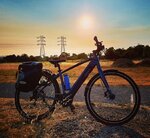Trail Cruiser
Well-Known Member
Good points, Mark. I use 20 Wh per mile as a rough rule-of-thumb, too.
Another, based on some data I recorded in April and May, is that watt-hours per mile is roughly equal to miles per hour. This seems a little counter-intuitive; wouldn't it go up when using a higher level of assist? But what actually happens is that to go, say, 15 mph in Eco, I pedal a lot, but in level 2 I pedal one or two turns, get a burst of speed, coast until it gets a little below 15, pedal one or two turns, etc. So I'm pedaling one-half the time that I would be in Eco, thus using more watts per stroke but fewer strokes per mile.
I wouldn't stake my life on this; I've developed a good feel for how many miles I've got in the tank based on the voltage level, and that's what I go by.
How much watt-hr is your battery?




